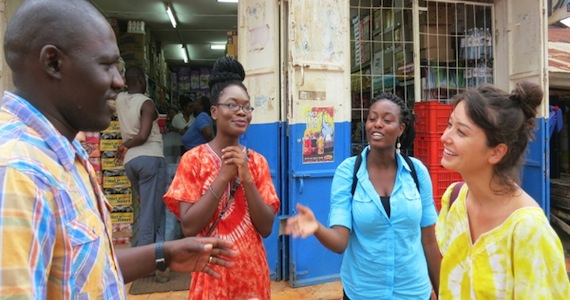Field Practice: Sub-Saharan Africa

Stepping off the plane in Dakar, Senegal after a long flight from New York City, SPH student Heidi West felt a sense of excitement, exhaustion and anticipation.
She, along with seventeen other students from the SPH, joined by professors from the SPH, were finally in West Africa after months of planning and studying about the strengthening of maternal and child health programs and health systems in Senegal and The Gambia.
It was a unique chance to get some field experience abroad. They are all enrolled in the SPH’s Global Health Certificate program, and this was a shocking, yet, calming moment.
“One of the things I was most excited about going into this trip was the opportunity to learn about the public health systems through a variety of different lens,” said West, who is the director of the Office of International Programs at Drexel University. “Participation in a diverse range of activities allowed us to see health through the lens of culture, history, clinical practice, academia, government and community.”
“The program allows students to combine coursework learning with a situation that reflects professional practice in global health and international development,” said Shannon P. Márquez, PhD, MEng, associate dean for academic affairs and the director of global public health initiatives.
The students were mentored by professors who teach in the global health program, including professors Al Jatta, Márquez and Tererai Trent, PhD, who is an internationally known humanitarian renowned for her work with Oprah Winfrey building schools and improving the lives of women and girls in Africa. The students also worked closely with partnering preceptors from NGOs, international agencies, the Ministry of Health, and universities.
“Collaborating with our knowledgeable and well-traveled professors put me more at ease as we made our way to Senegal and The Gambia,” said Triza Brion ’14. “They prepared us mentally and intellectually prior to our arrival to these countries which made our experiences and interactions with local partners much more meaningful.”
The students focused on an examination of the most important causes of morbidity and mortality in the region, as well as cross-cutting global health issues such as the integrated management of childhood illnesses, reproductive health, monitoring and evaluation, and the role of traditional medicine and village health workers in the health system.
The Gambia is encircled by Senegal on all sides apart from its Atlantic coast. For this reason the two countries have a lot of cultural and ethnic ties. Senegal is a former French colony. The Gambia was colonized by Britain.
“This trip was a really eye-opening experience for me. I’ve studied public health issues on American shores, but never internationally,” said Brittany Coote ’14. “One aspect of the Gambian health system that was quite poignant was the resourcefulness of the health system.”
The Gambia and Senegal, in contrast to many of its West African neighbors, have enjoyed lengthy spells of stability since independence. The public health service delivery system in this region of sub-Saharan Africa is built around three levels and based on a primary health care strategy.
Primary healthcare is focused on villages and village health workers and traditional birth attendants are trained as lay health workers and then assigned to deliver primary health care and maternal and child health services to their village of responsibility.
At the intermediate level, health care is provided by major and minor health centers – which have small teams of doctors, nurses, and public health officers on staff – who oversee the village health workers. Village health services are complemented by reproductive and child health trekking visits
from the health centers at the intermediate level.
At the tertiary level, health services are delivered at general hospitals that provide specialized services. In addition, there are private clinics and NGOs operated clinics. Traditional medicine is also acknowledged as contributing significantly to the health of the population, and includes bone setters, herbalists, spiritualists, birth attendants and those who combine the methods.
“Traditional medicine is an integral part of the health sector in The Gambia,” said Brion. “Our class met with a group of Gunjur Health Center’s traditional birth attendants who worked as unpaid volunteers. We also met an herbalist from Ghana who had treatments for everything from obesity to cancer.”
“An alternative to treatment at the hospital, Gambians had access to medicines that were low-cost and even free for those who could not pay,” said Brion. “I noticed that these traditionalists were committed to improving the health of the Gambian people with little monetary incentive, but a lot of passion and dedication.”
In contrast to Senegal, healthcare facilities and training institutions are relatively sparse in The Gambia, though health services are being built up in the country and the University of The Gambia has prioritized initiatives to train more doctors, nurses, and public health officers.
“The Gambian health services system is mostly built to address infectious diseases, which are more prevalent than chronic diseases,” said Coote. “Western and traditional medicine are seamlessly combined to create a health system that works very well to deliver the necessary health services to the Gambian people despite its lack of resources.”
“This experience had a major impact on me and the way that I think about local and international collaboration for health systems improvement,” said West. “I am inspired by our Gambian colleagues and look forward to applying the lessons from this experience to my academic and professional engagement.”